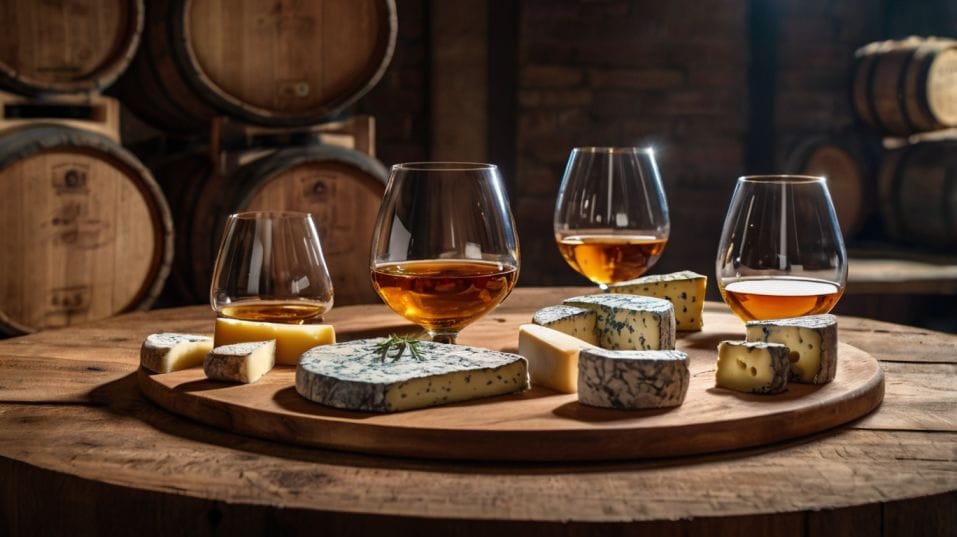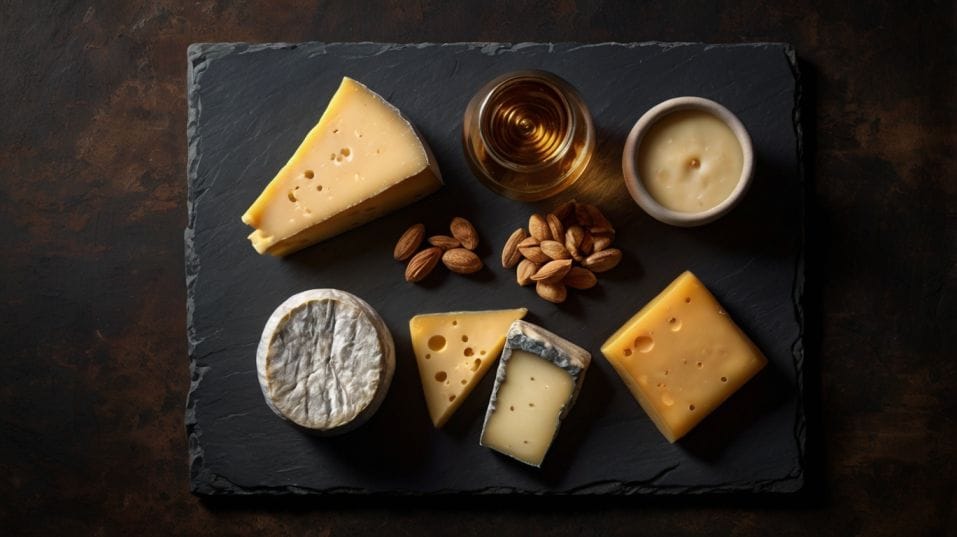The Best Cheeses to Pair with Whiskey
Pair whiskey like a pro with the right cheeses. Discover how salt, fat, and texture unlock deeper flavors and boost your tasting game.

Ever wondered why your whiskey still feels like a mystery, no matter how many bottles you try? The secret might be cheese.
Not as a sidekick, but as a tool—one that reveals what your whiskey is really made of. Forget chocolate and smoked snacks.
Cheese cuts through burn, teases out sweetness, and sharpens every note. If you're tasting with purpose, it's time to pair smart. Here's how to unlock your whiskey—one bite at a time.
Aged Cheddar: The Whiskey Workhorse
You can’t go wrong starting here. Sharp, crumbly cheddar is practically made for bold, oak-heavy whiskey. Think high-proof bourbon, sherry-cask single malts, or anything that spent real time in the barrel.
These whiskeys come with punch—vanilla, baking spice, char, maybe even some bitterness—and they need a cheese that can hold its own.
Aged cheddar brings acidity, texture, and a slow-building nuttiness. It resets your palate between sips without muting the drama. It also highlights caramel, maple, and toffee notes without making them cloying.
A few tricks to sharpen the pairing:
- Go for 12-month or older cheddar. Younger versions are too rubbery.
- Try it at room temp to maximize the cheese’s crystal crunch.
- Alternate bites and sips, not swigs. Let the textures meet, not clash.
Pairing tip:
Use cheddar when you're calibrating a new bourbon. It gives you a neutral, honest reference point to feel out the sweetness, spice, and finish.

Blue Cheese: Not for the Shy
This is the deep end. But if you’re ready to explore heavy peat, sherry bombs, or heavily aged drams, blue cheese is your best ally.
Stilton, Roquefort, Gorgonzola—they all pack salt, fat, and earthy, wild intensity. Which makes them perfect for unearthing the complexity buried in smoke, sulfur, and wood.
With peated Scotch—especially from Islay—the mold and brine of blue cheese connect with the maritime funk in a way no other pairing can.
What seems overpowering on its own becomes nuanced when combined. The iodine turns savory. The smoke smooths out. You start noticing minerality, leather, dried fruit, even herbs.
With older sherry-aged Scotch, the story changes. The cheese brings freshness to the whiskey’s dense, sometimes overly oxidized profile. Think: rich meets rich—but balanced by salt and acidity. No fatigue. Just clarity.
Real-world application:
Use blue cheese to test whether a peated whiskey has real structure or is just loud. A great bottle will hold up. A mediocre one will get steamrolled.
Washed-Rind Cheese: The Quiet Disruptor
Not everyone’s go-to, but it should be. Washed-rind cheeses—like Taleggio, Reblochon, Epoisses—smell intimidating, but they play incredibly well with delicate grain whiskeys and high-malt blends.
These whiskeys often get ignored because they’re soft, floral, and subtle. Which makes them hard to appreciate—until you add the right contrast.
Washed-rind cheeses bring body without aggression. Their creamy texture and mild funk draw out the spice, honey, or herbal notes that might otherwise get lost. They don’t fight the whiskey. They reveal it.
This pairing works best when you're exploring:
- Irish pot still whiskey
- Japanese blends
- Single grain Scotch or bourbon mashbills with high corn content
Technique tip:
Let the cheese warm up before tasting. Cold, it’s just butterfat. Warm, it’s alive—and your whiskey will be, too.
Alpine Cheese: Where Structure Meets Subtlety
There’s a reason Gruyère and Comté are favorites in wine circles. They bring nutty sweetness, layered umami, and a smooth, firm texture that matches almost anything.
That adaptability works just as well for whiskey—especially balanced Highlanders, Speysiders, or younger single malts that lean fruity or floral.
With a well-made Glenlivet-style malt, alpine cheeses help expand the mid-palate. You’ll notice more pear, almond, cereal, or grassy tones after just a few bites.
The finish lengthens. The malt speaks more clearly. No surprise, these cheeses are aged—usually 12 to 24 months—just long enough to concentrate flavor without turning brittle or sharp.
Collector insight:
If you’re comparing similar malts and trying to learn what sets them apart, alpine cheeses can act like a lens. They clarify, not distract. Think of them as your tasting lab’s baseline.
Bloomy Rinds: Taming the Young and the Restless
If your whiskey is bright, grassy, sharp, or a little green, pair it with Brie, Camembert, or anything in the bloomy-rind family.
These cheeses bring soft ripeness, mushroomy depth, and a fluffy, silky texture that tames rawness and brings sweetness into focus.
These pairings shine with:
- Young bourbons under 4 years
- Unpeated Speyside or Lowland Scotch
- Irish blends and triple-distilled whiskies
The key is texture. The cheese coats the palate and draws the whiskey forward. It’s not flashy—but it’s where new tasters often have their first click moment: when a whiskey that felt too sharp suddenly feels smooth and generous.
Technique tip:
Don’t overpour. Lighter whiskeys show better in small sips. Let the cheese lead and use the whiskey to chase, not the other way around.
Why It Matters (And Why It Works)
Great pairings make you a better taster. They teach you to:
- Notice structure, not just flavor.
- Understand how weight, texture, and salt influence sweetness and burn.
- Taste your whiskey in layers, not gulps.
This has nothing to do with party tricks or Instagram-worthy boards. It’s practice. It’s palate-building. And it pays off—especially if you're collecting and want to know what a bottle really offers before you commit.
You’ll start identifying cask influence, fermentation character, and age markers with more confidence. Not because you memorized tasting notes—but because you trained your palate to feel them.
Final Thoughts: Build the Palate, Not the Hype
Whiskey isn’t just a drink—it’s a craft. And the more tools you have to decode it, the better your collection, your tastes, and your conversations get. Cheese is one of those tools. Humble, unglamorous, powerful.
So start experimenting. Slice something aged. Pour something new. Don’t just sip—test. Try contrast. Try complement. Let every pairing teach you something.
Today, you don’t need a rare bottle to taste like a pro. You just need a wedge of cheese, a clean glass, and a little intention.




